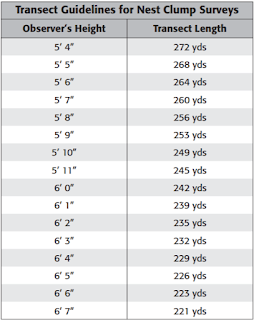By: David Riley Texas A&M WFSC '14
As a land manager one, of the most important things
you can do is monitor habitat availability and quality for the species that you
are managing. Proper grassland habitat
is necessary of ground nesting birds, especially game bird species like the northern
bobwhite quail (Colinus virginianus; hereafter quail). Being able to quantify the amount of habitat
you have in a given area can be very important when determining a carrying
capacity and how to improve land to increase carrying capacity. Monitoring quail habitat gives you an estimate
of useable space available to quail, the potential for quail to survive and
reproduce in the area, and the outcome of management efforts toward habitat
(Wright et. al.). Ground nesting birds
such as quail prefer to nest in the center of clump grasses rather than under
brush. An effective way of monitoring
quail nesting habitat is by conducting nest clump surveys, which can be
utilized by landowners and managers of all different skill sets and knowledge
backgrounds.
 |
| Conducting a nest clump survey (Wright et al. 2005) |
Nest clump surveys also do not require much equipment or previous knowledge of plants to conduct. Although nest clump surveys are often a starting place for landowners and managers, they can also be used to determine specific problems. Below are steps for how to set up and conduct nest clump surveys.
|
- Establish transects using 6-foot t-posts (once
the t-posts are placed, don’t move them as they will be necessary for future
habitat monitoring)The goal of these transects is to have a defined
area of about 0.1 acres in size. The
length of the transect will be determined by the height of the observer, while
the observers arm span will determine the width. Examine the following table (Table 1) for the transect length
according to your height.
Table 1: Transect Guidelines for Nest Clump Surveys (Wright et al. 2005). - Begin by driving a t-post at the beginning of the transect. Be sure to drive the t-post deep enough where it cannot be uprooted by other wildlife but can be easily seen by people. Using a measuring tape, measure half of your transect and place a second t-post. This t-post in the middle of the transect will be used as a guideline to stay on course during your nest clump surveys. Finally measure the second half of the transect and place a third t-post at the end of the transect. Be sure to maintain a straight line while establishing the transect
After establishing transects, it is time to begin recording data for your habitat analysis.
- Begin at one end of your transect and with your
arms stretched out horizontally begin walking and counting adequate nesting
sites under arm span. Adequate nesting
clumps consist of clumps that are roughly the diameter of a basketball and
stand atleast 9-12 inches in height (Lehmann, 1984). Clumps of prickly pear that are at least the
diameter (3ft) of a normal hula hoop are also adequate nesting sites for quail(Wright
et. al.).
- Fill out a nest clump data sheet which can be found in “Habitat Monitoring for Quail on Texas Rangelands” with the necessary information such as the number of clumps
counted and transect information. After
filling out the data sheet and making the proper calculations the far right
column will give you the estimated amount of nesting sites per acre.
Literature
Cited
Wright, B. D., J. C. Cathey, and R. K. Lyons. 2005. Habitat
monitoring for quail on Texas rangelands. Texas A&M Agrilife Extension B-6172. College Station, Texas, USA.
Lehmann, V.
W. 1984.
Bobwhites in the Rio Grande Plains of Texas. Texas A&M University
Press, College Station, Texas, USA.
